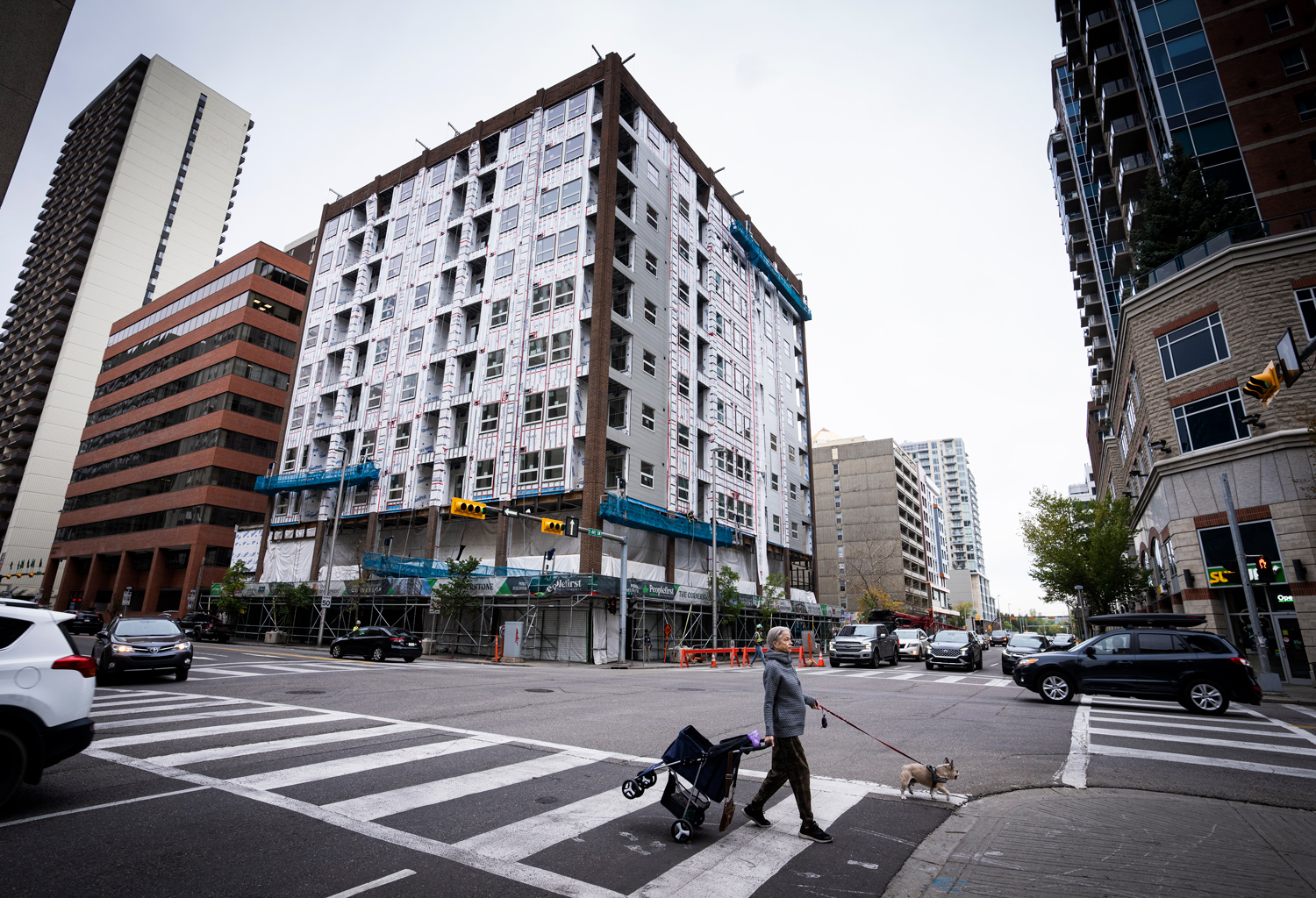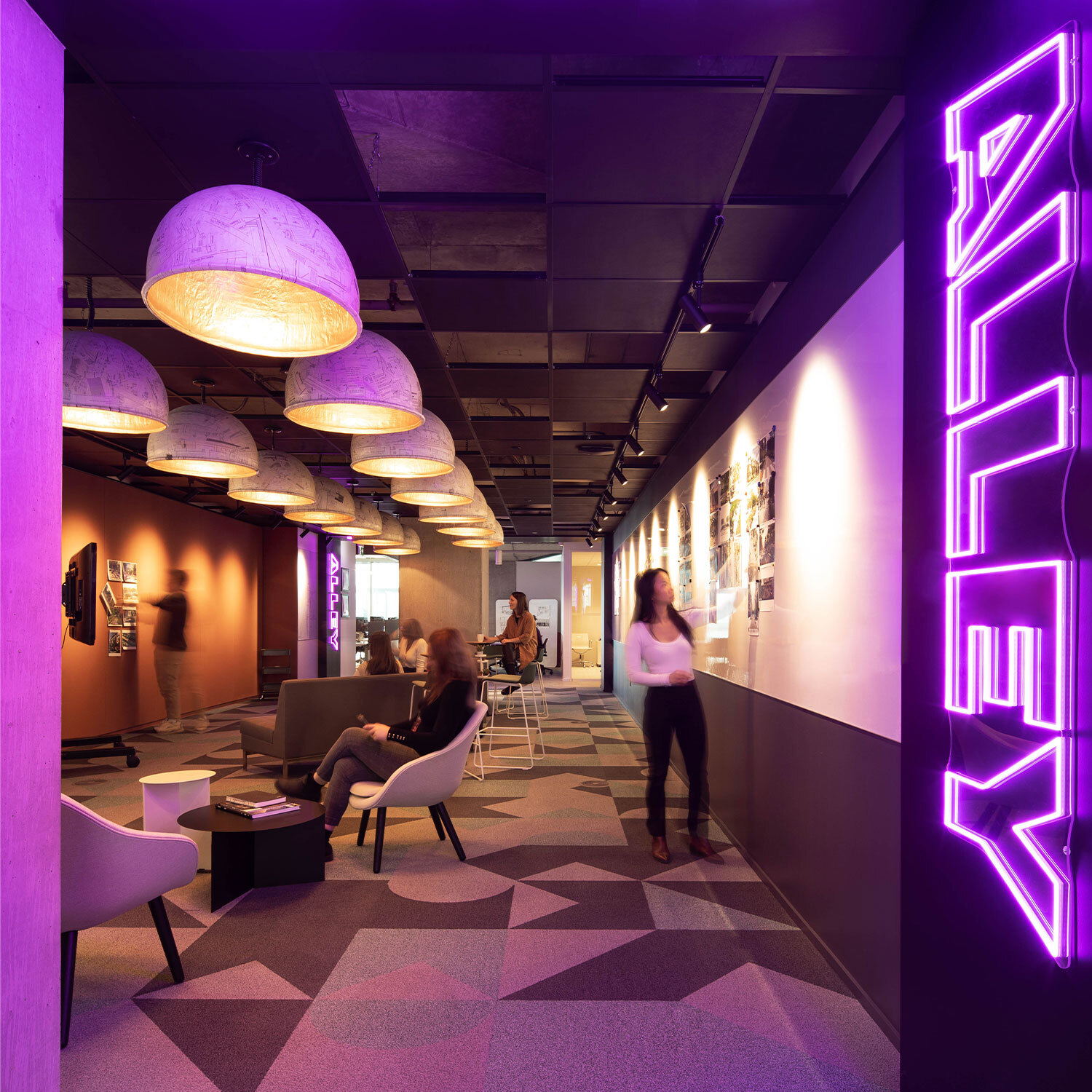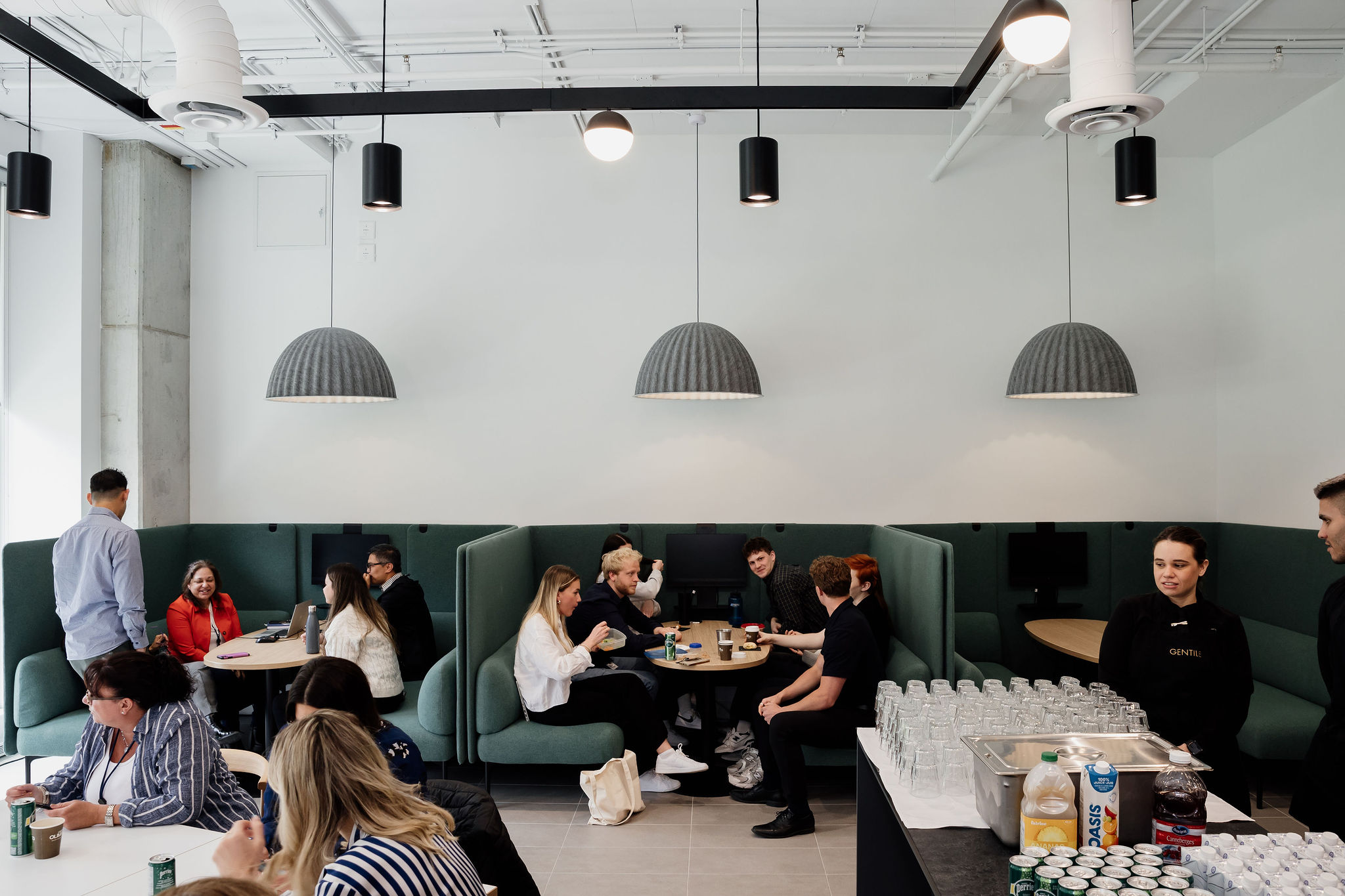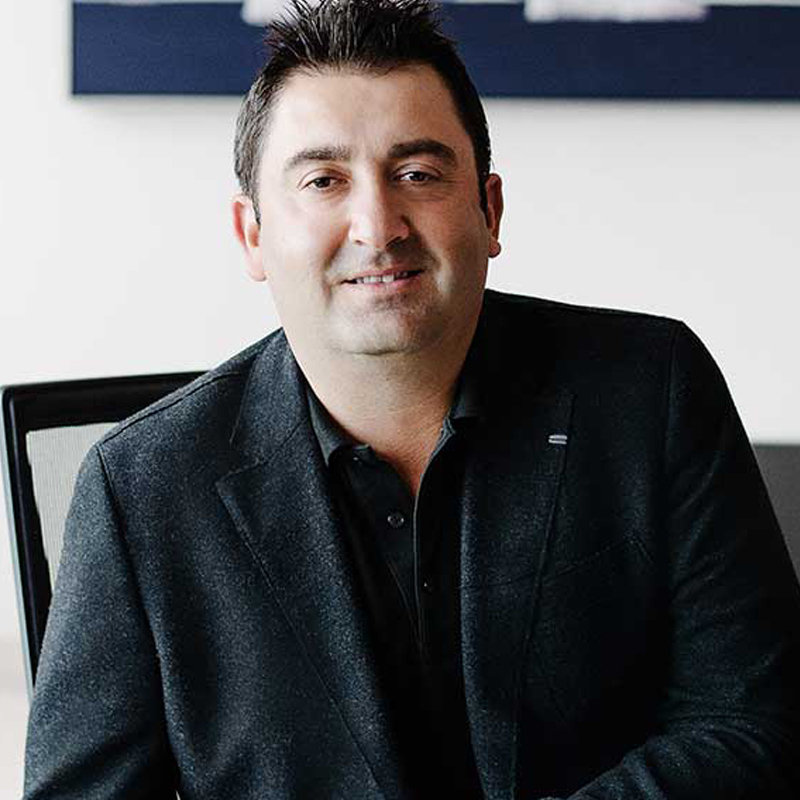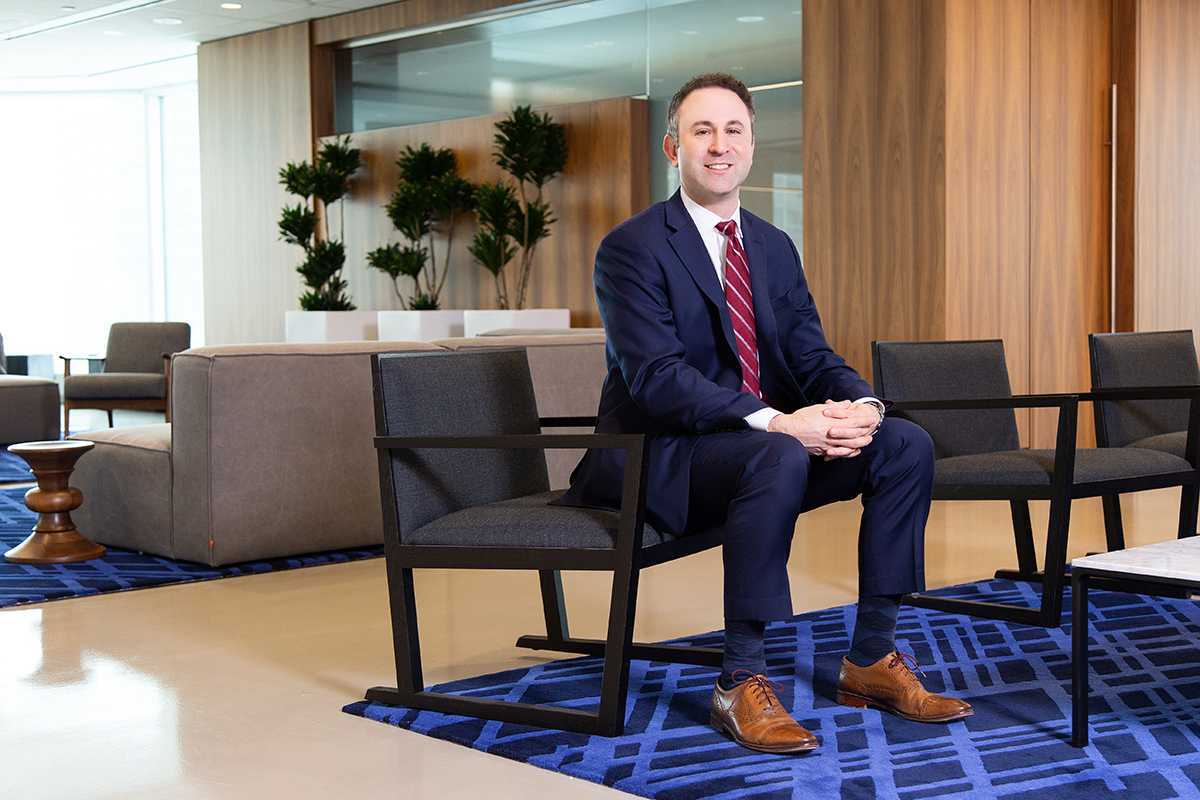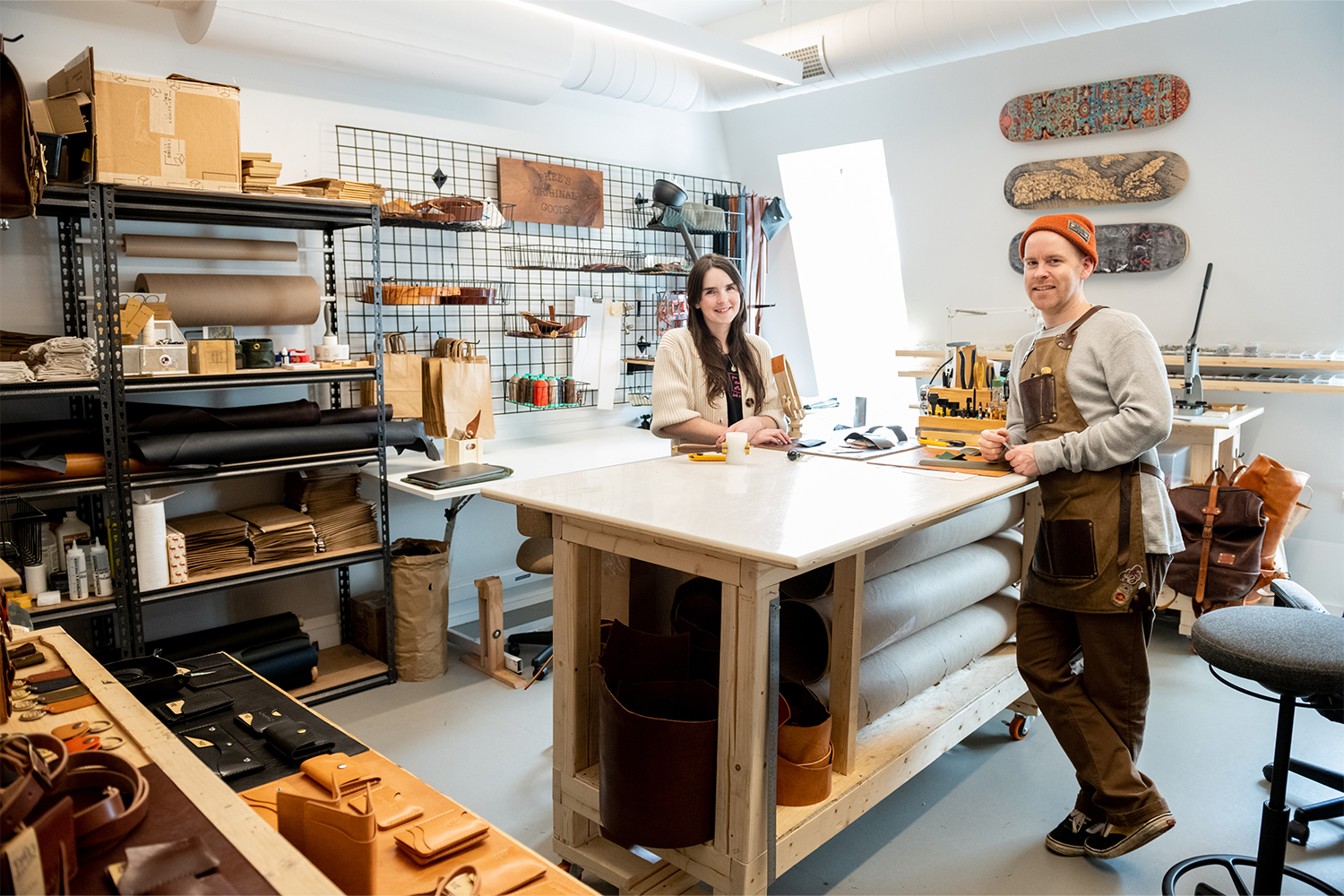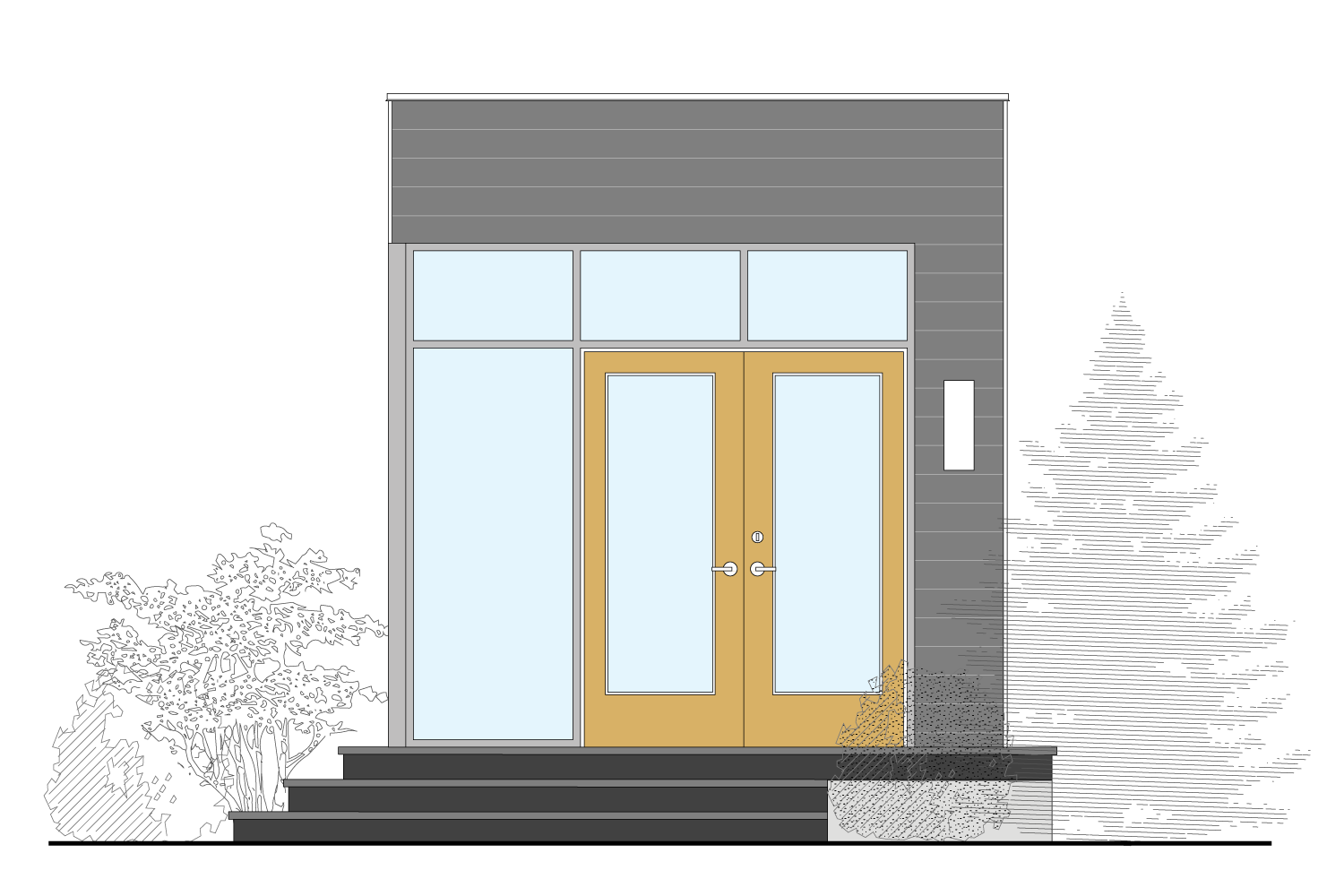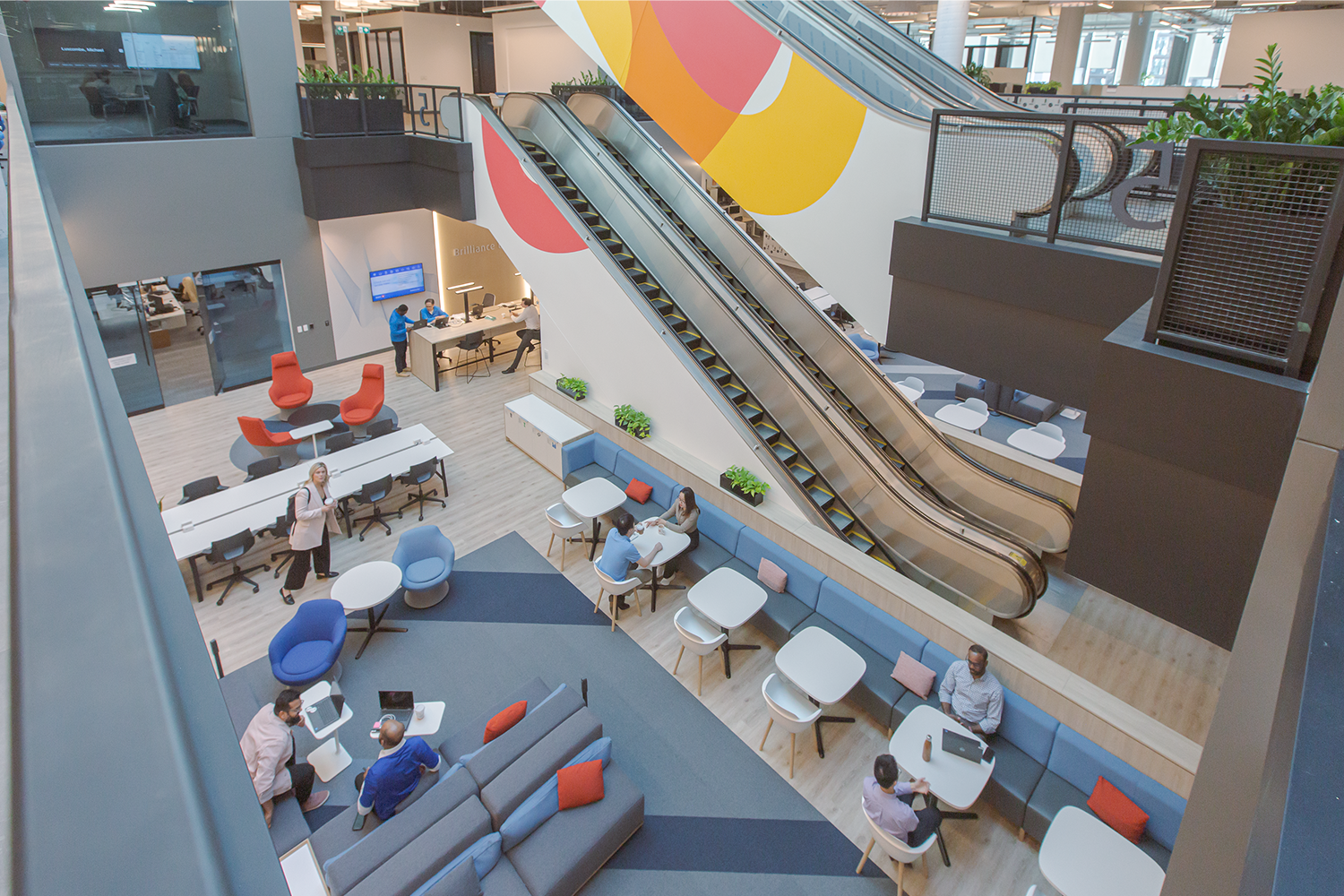When Maxim Olshevsky stepped inside 909 5th Ave. SW, a 10-storey building in downtown Calgary, he could have sworn he was looking at the aftermath of a zombie apocalypse. Frayed cubicle walls loomed over piles of expired contracts; name tags lay abandoned on dust-blanketed desks. To most, this would be source material for an episode of The Last of Us; to Olshevsky, a Calgary-based real estate and construction entrepreneur with a soft spot for bringing things back from the dead, it was pure potential.
A hot tip had led Olshevsky to the site in 2021; in the four years prior, his company, Astra Real Estate Group, had focused on foreclosed and condemned buildings, projects in need of a serious overhaul. “That became our niche,” he says. “All of a sudden, we started getting calls: ‘Hey! Wanna look at this building that’s falling apart?’”
Having established himself as a de facto fixer of fixer-uppers, Olshevsky was unfazed when he surveyed what remained of 909. The mid-rise, built in 1979 according to aesthetic specs reminiscent of a Buick Skylark, had been mostly abandoned since 2015, when SNC Lavalin rescinded its naming rights and pulled its operations; while two straggler tenants remained on-site, the bulk of its 12,000-square-metre space was empty. But Olshevsky sensed he was standing on the ground floor of an innovative development opportunity.

“I thought that if this building sat here like this for almost 10 years, how many other commercial buildings in Calgary were in the same condition?” says Olshevsky. A year into the Covid pandemic, it was clear that the hordes of workers who’d gone virtual were unlikely to return to their bricks-and-mortar home bases—at least, not en masse. Factor in a widespread housing crisis, and the solution seemed clear: What if these abandoned office spaces could be acquired, overhauled and repurposed into residential units?
Around the same time, Calgary’s municipal government was working out the final details of a strategy aimed at tackling a plummeting commercial real estate market and revitalizing the city’s central core. In April 2021, city council approved Calgary’s Greater Downtown Plan: Roadmap to Reinvention. Acting on a key pillar of the decade-long program, the city flagged its intention to get rid of 557,420 square metres of unused office space—and announced it would be offering grants to developers willing to take on the challenge of transforming that space into something new. Residential-conversion projects—the focus of that initial phase—were eligible for grants of $75 per square foot, up to $15 million.
Olshevsky eagerly applied as part of the first cohort, explaining the full extent of what he wanted to do with the building—create family-friendly units with modern amenities and a ground floor dedicated to retail—in his application. His proposal for 909 5th Ave. SW was approved a few months later. Dubbed “The Cornerstone,” it received an investment of $7.8 million in municipal funds to convert approximately 9,662 square metres. The project broke ground in late 2022 and is on schedule to be completed by January.
But for Olshevsky, it was just the beginning. The 36-year-old developer, who immigrated to Calgary from Ukraine at 13 and grew up in the downtown area, had been working in construction since he was 16, when he started out installing wood floors. He went on to expand his skills as a contractor and eventually gravitated toward conversions, in part because he realized he could seize on the value of projects that other people didn’t want to take on. “We understood that even though these buildings were neglected, it was much better to bring them back to the community than leave them boarded up,” says Olshevsky.
Related: This Former Convent in Nova Scotia Is Now a Vibrant Arts Hub
The Cornerstone project became, well, the cornerstone of Peoplefirst Developments—a subsidiary of Astra Real Estate Group—where, as managing director, Olshevsky hinges his key strategy on office-residential conversions. In February, Peoplefirst acquired the Petro-Fina Building, a mid-century midrise at 736 8th Ave. SW, one block east and about four blocks south of The Cornerstone. Shortly thereafter, Olshevsky added Place 800—a 17-storey behemoth on 6th Ave. SW, smack dab in the middle of the two other properties—to his portfolio. “I was like, we have to secure our place. Otherwise, all the big boys—the larger and more established development firms—will come in and scoop up all these projects.” Peoplefirst currently has more than 46,450 square metres under conversion, all in the downtown core.
This past April, the City of Calgary unveiled the five office-residential conversions (by five different developers, including Peoplefirst, whose Petro-Fina project is on the docket) approved under Phase Two of the Greater Downtown Plan, bringing the grand total of works in progress to 10 since the program was rolled out in 2021. As Mayor Jyoti Gondek noted at the press conference, where she announced the latest slate of projects, these transformations will do away with millions of square metres of currently unused office space and contribute more than 1,200 units to Calgary’s housing supply.
A report published in May pegged Calgary’s population at 1,389,000—an increase of about three per cent compared to the previous year, marking the greatest increase on record. This trend, which reflects recent federal initiatives to encourage migration to Alberta, is in line with what’s happening across the whole country, which saw the highest rate of first-quarter growth since 1972—0.7 per cent, or nearly 300,000 people. And that spike built on another milestone: The year 2022 marked the first 12-month period in Canadian history when the population grew by more than 1 million people. Statistics Canada estimates that the country will be home to 45.5 million people by 2040 and 52.1 million people by 2060, and all those people will need places to live—specifically, places that they can afford.
“I thought that if this building sat here like this for almost 10 years, how many other commercial buildings in Calgary were in the same condition?”
For a city—or province, or country— to thrive, it needs a thriving commercial sector. And for a business to thrive, it needs to attract in-demand talent. If a potential candidate can’t find an affordable place to live in the general vicinity of a potential job, it’s unlikely they’re going to relocate to accept that job. As well, housing shortages and sky-high rents can have a domino effect on commercial real estate, which can prompt companies to literally take their business elsewhere. In Calgary, the average rent for a one-bedroom apartment was hovering around $1,825 in September 2023—a jump of 26 per cent year over year. Based on the City of Calgary’s 2023 Housing Needs Assessment, a resident would need to make an average of $84,000 a year to keep pace with current market rents—a figure that has increased outrageously from 2022, when an average salary of $67,000 was sufficient.
At first glance, it’s hard not to think like Olshevsky—surely these projects are a no-brainer. If workers are fleeing downtown cores like humans fleeing a zombie invasion—and, at the same time, cities across the country are struggling with a lack of adequate housing to meet the needs of their evolving populations—then it follows that transforming any and every abandoned office tower into residential units is effectively killing two birds with one stone. The trick, of course, is that it’s not quite as simple as that tidy narrative would lead you to believe. For starters, buildings are wildly varied. Cities are wildly varied—geographically, bureaucratically, economically, demographically. And if the past four years have taught us anything, it’s that a strategy that doesn’t account for variability is doomed to fail.
As pilot projects go, Calgary’s Greater Downtown Plan has been a great success, at least in terms of program uptake, red-tape reduction and overall momentum related to revitalization. Earlier this year, The Washington Post proposed that the municipality should be a model for North American cities looking to reinvigorate their central cores. But when it comes to downtown wastelands, Calgary is—and was—in a class of its own. While other places—from Washington, D.C., to Montreal—were left reeling when their economic centres were devastated by the effects of the pandemic, Calgary’s issues started long before Covid. The current state of the city’s core can be traced back nearly a decade, to around 2014 or 2015, when a major recession in the oil and gas sector was a catalyst for a slow, steady decline.
Downtown Calgary was effectively developed at the behest of the oil and gas companies—reliant on the province’s seemingly unassailable natural resources—which began establishing their headquarters in the urban core in the late 1940s and early 1950s. For years, those corporations—and the ancillary-use companies orbiting them—kept downtown bustling. While there were downturns prior to the 2014 recession, the lulls were always shorter and less severe. After a huge boom in the 1970s, for instance, overzealous expansion and a global recession resulted in an early-’80s bust, but ever-increasing worldwide demands for fossil fuels meant things were back on track by the end of the decade. But in 2014, when oil prices plummeted due to unprecedented global supply growth, there was no bouncing back. By March 2016, about 100,000 jobs in the oil patch had been cut. In turn, there was a mass exodus from Calgary’s core: Between 2015 and 2021, the area lost approximately one-third of its tenants.

This was the crisis presented to city council back in 2019, when Natalie Marchut, manager of development and strategy in Calgary’s Downtown Strategy unit, and her colleagues began developing their revitalization plan. They were facing several issues that cropped up in a domino effect: The glut of underused office buildings in the downtown core caused property values in the area to drop, which, in turn, led to a need to redistribute taxes to other non-residential properties. The result was a ghost town that was created by a corporate-centric monoculture. Even if there had been a surplus of housing available in the core, it would be hard for anyone to imagine themselves living there.
“Year over year, we were not seeing any plans from building owners to do anything different—the buildings were just sitting vacant,” says Marchut. “In early 2022, we were sitting at about 34 per cent vacancy just in the downtown area, which equated to about 1.3 million square metres of unused space.” (In the second quarter of 2023, downtown Calgary’s vacancy rate was 31.5 per cent. For comparison, the rate in Vancouver was 11.5 per cent at that time, while Toronto’s was nearly 16 per cent.) Covid may not have caused the problem, but it compounded it. “Property values across the city dropped by $16 billion, collectively,” Marchut says. “If you do the math on how that affects tax revenues, it’s significant.”
By the time Marchut and her colleagues launched the program, in September 2021, they had determined that the best way to tackle the revitalization was to make the process as simple and seamless as possible. The only requirements placed on Phase One proposals—like Peoplefirst’s Cornerstone—were that the projects needed to be a) residential conversions, b) of office buildings and c) in the downtown core. The no-strings approach brought forth debate. “We had internal folks asking: Could you have a climate requirement? Could you have an affordable-housing requirement?” says Marchut. “Those things are super important, but we intentionally kept it really simple because we were laser-focused on addressing the vacancy crisis.”
Their strategy paid off. Marchut and her colleagues had anticipated maybe five candidates in the initial round—they received 13 applications, mostly from traditional developers. The uptake of that initial round of projects encouraged them to add conditions for Phase Two applicants, such as amenities at ground level. There are also add-on incentives, like the Downtown Retrofit Challenge, a competition-style grant—open to projects approved through the Incentive Program—of up to $1.2 million that was designed to help offset costs related to emission reductions and climate-resilience measures.
When the Downtown Strategy unit was hashing out the terms of the Incentive Program, they landed on $75 per square foot, which, based on an analysis of average conversion-construction costs at that time, was meant to cover approximately 25 to 30 per cent of the total budget. And for the initial round of projects, Marchut says, they were more or less bang on. But since then, due to inflation, interest rates and other market factors, the grant has covered proportionally less than it did in Phase One; in response, she and her colleagues are in the process of reviewing the rates. “It’s a fine balance of offering enough that people will come to the table while not offering so much that the city is spending too much money.” In other words, it’s about considering constantly evolving factors, like housing prices, to ensure that these projects remain viable.
That balance is key to making sure that developers are willing to take on the risk of conversions—unforeseen costs may be too much of a deterrent otherwise. One of the biggest challenges, Olshevsky says, is that conversion projects don’t adhere to a conventional order of operations. That’s because you can’t always predict what those steps will be. With an existing structure, there are tasks that are often only discovered once you start the work. “It’s like when you buy a house, and then you realize they did DIY ductwork and everything is venting into the walls, and all of a sudden you’re screwed,” says Olshevsky.
“Year over year, we were not seeing any plans from building owners to do anything different—the buildings were just sitting vacant”
Building codes—their importance, their flexibility, their sometimes anachronistic nature—have been a central hurdle in this process. Many of the buildings being converted date back to a time when the codes were very different. “Stairwell requirements have changed since the ’80s, but stairwells can’t be changed in a concrete-cast building,” Marchut says. “You can’t move or expand that element.” The ongoing conversation is where to find balance: How much can a regulation be relaxed? If a building exists—and has been occupied by office workers—is it fair to just make an exception? “Each project is so unique that we deal with them on a case-by-case basis,” she says.
Olshevsky’s team of about 20 people also brought a kind of outside-the-box thinking to their financing of the Cornerstone project. Peoplefirst received $7.8 million in municipal funds for the conversion, which had a proposed budget of $38 million. To help cover the remaining costs, it used the start-up Addy, a crowdfunding platform that turns individuals into real estate micro-investors. Within two weeks of launching the campaign, Addy hit its goal, raising $500,000 from 800 contributors, each of whom kicked in, on average, $600. As Olshevsky explains, every one of those micro-stakeholders receives the same return on their contribution, percentage-wise, as, say, an accredited investor who ponies up $3 million.
The amount of financial backing a project receives also informs how developers like Olshevsky might design their conversions, like whether they will include larger, more family-friendly units. Technically, he says, it can be cheaper per square metre to build a bigger unit. But when it comes to leasing out those same units, as any savvy REIT will note, you can’t rent them out for the same price per square metre. “I can do a three-bedroom for $3,000 or three one-bedrooms for $1,600 apiece.” While this conundrum is not specific to office-to-residential conversions, there’s a different kind of pressure involved in figuring out how to facilitate the inclusion of more diverse and more affordable options because these projects are anchored in a broader discussion around downtown revitalization. To create a city core that is vibrant and accessible to all residents, you must ensure you’re creating spaces that meet the needs of those residents.
Related: How to Create a Child-Friendly Workplace
Obviously, Calgary is far from the only place where the conversion of derelict commercial space is a hot-button issue. Across the country, developers are seizing on these sites with gusto—and with varying degrees of both institutional support and success. Halifax-based Sidewalk Real Estate Development has applied what it describes as a holistic approach, braiding more ineffable considerations, such as sustainability, historical significance and the desire to catalyze “community pride,” into its search for commercial assets to overhaul. Though the firm is less than a decade old, it’s had a hand in breathing new life into downtown Dartmouth, where its revamped low-rise buildings line the main drag of Portland Street. Sidewalk’s latest Portland project involves converting the RBC Building—eight storeys of underused office space—into apartments. As VP Joe Nickerson explained in an online panel discussion in May, the company’s success hinges, in part, on understanding each development as one component in a larger ecosystem. “We’re long-term owners, and we’re heavily invested in the neighbourhoods.” For Sidewalk, this means creating stylish apartments that appeal to a younger demographic, and they’re layering these on top of restaurants and bars at street level, which encourages foot traffic and draws people from all over the city. To fulfill a requirement of funding they’ve received from the province, they’re also incorporating a healthy portion of affordable units—available for at least 20 per cent below market rent.
In Winnipeg, Alston Properties has been taking on increasingly ambitious conversion projects for close to a decade. The real estate and development company’s portfolio includes 433 Main St.—an austere 1970s-era tower that formerly housed Service Canada offices—where 10 storeys containing 94 residential units are now perched above four floors of commercial activity. In 2019, one of Alston’s projects, the Galpern Porter Building—a handsome brick edifice that dates back to the early 1900s and had, at various times, been occupied by a china wholesaler, a candy company and a nightclub— received a National Trust Award for “Transformative Projects.” The conversion contains more than 30 residential units within a meticulously restored heritage facade. Company founder Bryce Alston has benefited from the support of municipal and provincial grant programs, which, akin to Calgary’s Greater Downtown Plan, provide incentives to developers who convert heritage buildings into rental properties.
“You can actually invest a few million and end up with a building that’s worth less than that”
Such collaborative efforts between different levels of government are a crucial determinant of success in this context. In “The Case for Conversions,” the Canadian Urban Institute (CUI), a national non-profit dedicated to city building, assessed six municipalities across the country—Victoria, Regina, Winnipeg, Ottawa, Moncton and Halifax—to come up with a set of conditions that favour commercial-to-residential conversions. The report found that, along with building typology and location, policy and economic conditions are the two most influential areas where governments can play a role in increasing the viability of conversion projects through measures like adaptive regulations, more flexible zoning and incentivization programs.
To be fair, even the best-laid and -incentivized plans don’t always bear fruit. In 2022, real estate broker Chris Tammi bought a mixed-use low-rise in the downtown core of Sudbury, Ont., with the aim of turning the structure—formerly the site of an insurance company—into a multi-unit residential complex balanced on main-floor commercial space. Although the city had recently bolstered its grant program, offering $20 per square foot or $20,000 per unit for office-to-residential conversions, Tammi’s experience illustrates why subsidies alone aren’t enough. In this case, bringing the building up to code would have involved so many alterations that the overhaul wouldn’t pay off. Factor in the cost of site remediations based on environmental assessments (a concern in Sudbury, where the spoils of heavy industry are widespread) and, as Geoff McCausland, a former city councillor in the region who now works alongside Tammi, told the CBC, “You can actually invest a few million and end up with a building that’s worth less than that.” It’s an important reminder for would-be developers: Before you buy, do your homework. And it’s an important lesson for cities: Simply directing funds to the private sector without considering the overall landscape is inadequate when you’re trying to solve both a commercial real estate problem and a housing one.
For this reason, Jennifer Barrett, CUI’s managing director, says that conversion is only one piece of the puzzle—green spaces, businesses and services are all needed to create a vibrant neighbourhood. She’s in favour of plans that compel developers to optimize all ground-floor footage, taking space away from empty lobbies for retail or other uses, such as child care, cafés or artists’ studios, that animate the streetscape. “There’s always this complexity in an urban environment: How many regulatory strings can you pull to get a grocery store in the area, or a pharmacy or medical facility? Cities have gone through all sorts of regulatory challenges in trying to curate a main street or commercial core that has the right mix.” Daycare, for example, can be operated by a private company, so a government can’t mandate that one open in a certain area. Likewise, green spaces and playgrounds must be created over time as land and funding become available.
In early 2021, it became clear that the pandemic had dealt a devastating blow to pretty much every urban centre across Canada: Workers abandoned office towers; austerity, inflation and the intense claustrophobia of being trapped at home prompted families to seek out space and affordability in the suburbs and beyond. CUI ramped up its ambitious project to jump-start the sluggish hearts of cities across the country with a campaign dubbed Bring Back Main Street (BBMS), a callback to a time when a city’s primary thoroughfare was equal parts economic centre and community gathering place. The organization enlisted the help of a cabal of experts to develop a vision for not just rebuilding but also reconceiving the central parts of our municipalities. The questions that needed to be answered were deceptively simple but epic in their scope: What do we want the future to look like? What do Canada’s cities need their downtowns to become?
CUI determined that all downtowns are subject to three possible futures: 1) complete abandonment (the worst-case scenario, akin to a zombie apocalypse—visions of which can be seen in Nova Scotia’s Cape Breton Regional Municipality, an area that’s riddled with condemned commercial spaces, some of which have been taken over by squatters); 2) increasingly prohibitive costs, rendering the core accessible to only the wealthiest; and 3) a more optimistic outlook, in which concerted recovery efforts prioritize diversity, creativity, flexibility and environmental and economic sustainability.
In working to achieve this third option, Marchut notes, many cooks in the kitchen may be the best thing. “I’ve been working for the city for 10 years, and I’ve never seen so much collaboration toward an outcome,” she says. For her, the biggest shift affecting the future of Calgary’s core involves the collective engagement of civic partners, city council, administration and industry. “We would not be on the track we’re on now if that hadn’t happened. Even many of the suburban councillors, whose constituents don’t live in this area, have come together to advocate because they see the importance of downtown for Calgary as a whole.”
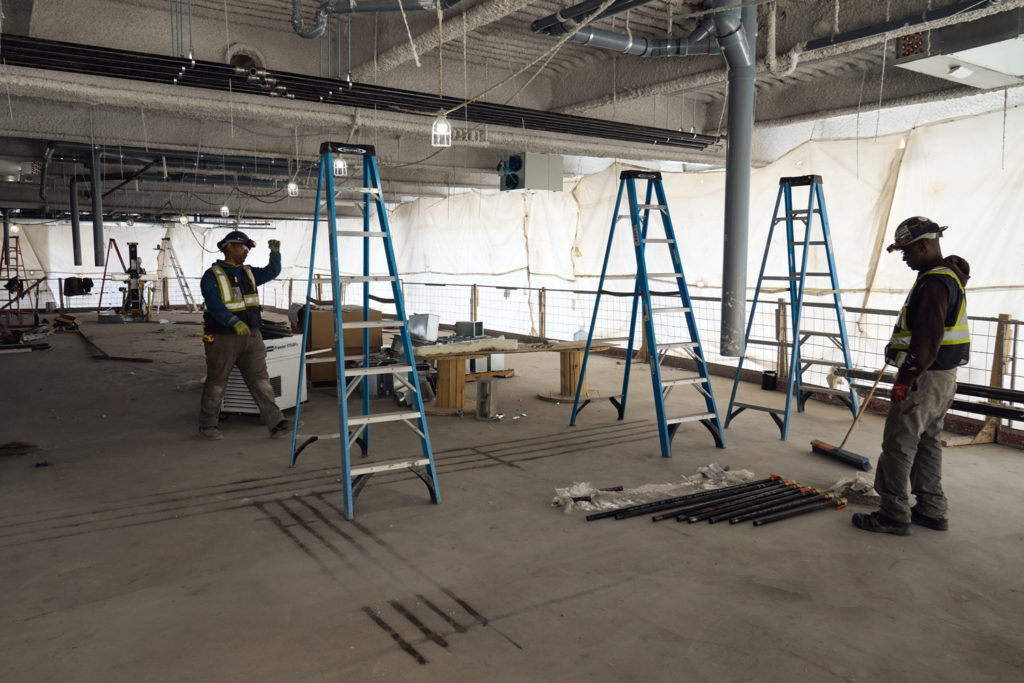

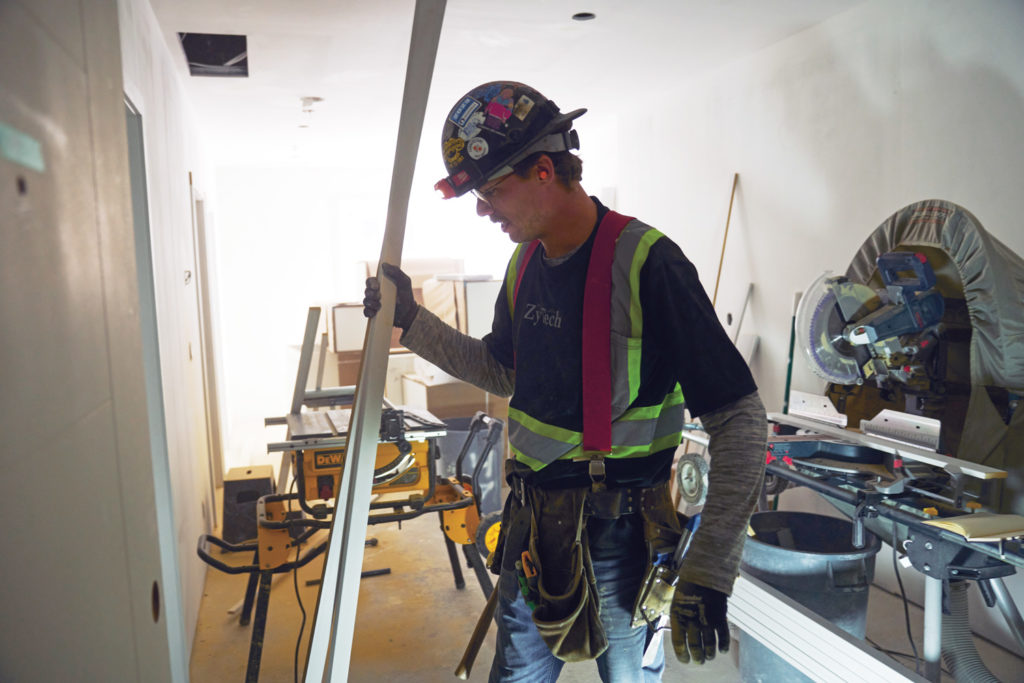
Crucially, recruiting key stakeholders to shape initiatives is part of ensuring that the outcomes reflect the most essential needs—not only for those looking to live in future units but also in terms of the broader requirements of a thriving city. This might include targeted neighbourhood assessments to determine what elements are missing from a certain area. In Calgary, city staff teamed up with the Urban Calgary Students Association, a group affiliated with the University of Calgary, last January as part of an unconventional blue-sky session aimed at soliciting young people to help reconceive the core. They would, after all, become the next wave of people entering the workforce and, ideally, living and working downtown. The project, called Sketch Mob, invited these students to three downtown stretches in prime riverfront locations—all coincidentally within a stone’s throw of Peoplefirst’s conversions—where they were tasked with sketching ideas on how to improve what they saw. Findings included walkability—that is, having a variety of amenities, like grocery stores and entertainment, within a small radius—and access to transit.
The Downtown Calgary Development Incentive Program has evolved in the two years since it launched. The municipal program now includes tiers of funding for non-residential projects—office-to-hotel conversions can receive up to $60 per square foot, while towers that are transformed into schools and arts centres are eligible for $50 per square foot in grants. Right now, enterprising individuals are finding vital new uses for spaces that have gone neglected. In the Calgary Tower Centre, a 24,387-square-metre skyscraper in the downtown core, a company called AgriPlay has rented out an entire floor and transformed it into a vertical farm that produces everything from greens to strawberries. In Alberta—the province with the highest rate of food insecurity in the country—the prospect of turning unused office space into de facto farmland may help tackle a separate (but equally important) challenge in revitalizing the core.
Related: BMO’s New Toronto HQ Is Inside a Converted Department Store
For cities—and citizens—around the world, the pandemic catalyzed a Great Reset, an opportunity to re-evaluate the aspects of everyday life that were no longer relevant or effective, with the hope of devising a new and better way forward. What Calgary offers in the wake of its own Great Reset is a vision of where other struggling cities might be five or 10 years from now. But even this plan is evolving in real time. Growing awareness around climate issues and skyrocketing costs of materials are part of the puzzle.
Olshevsky says that this isn’t a case where “if you build it, they will come” can suffice. If these conversion projects are ultimately going to be successful, then they need to become commodities in high demand—otherwise, many developers aren’t going to feel especially compelled to take on the potential risks and unforeseen costs. And for that to happen, the projects need to be anchored in spaces where prospective residents can already imagine themselves. When Olshevsky imagines a possible future, his mind goes not to Manhattan or to other North American centres but to the bustling cities in Europe and Latin America, where cores are anchored in the idea that downtowns are not simply places you go to work, hammer out a deal over lunch and then take the train home from. Transforming office towers is a start, but vibrant cores are collective efforts—a combination of policy, funding, community consultation and capital projects. “Remove the barriers to creativity,” says Olshevsky, “and people will create things for others to come.”
